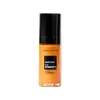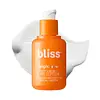What's inside
What's inside
 Key Ingredients
Key Ingredients

 Benefits
Benefits

 Concerns
Concerns

 Ingredients Side-by-side
Ingredients Side-by-side

Water
Skin ConditioningAscorbyl Methylsilanol Pectinate
AntioxidantPropanediol
SolventGlycerin
Humectant3-O-Ethyl Ascorbic Acid
Skin ConditioningSilica
AbrasiveParfum
MaskingGlucosyl Hesperidin
HumectantSodium PCA
HumectantAnogeissus Leiocarpa Bark Extract
Skin ConditioningSodium Hyaluronate
HumectantTocopherol
AntioxidantBeta-Carotene
Skin ConditioningBisabolol
MaskingAdenosine
Skin ConditioningSaccharide Isomerate
HumectantSodium Lactate
BufferingCitric Acid
BufferingGlyceryl Caprylate
EmollientXanthan Gum
EmulsifyingCaprylic/Capric Triglyceride
MaskingSclerotium Gum
Emulsion StabilisingGlycine Soja Oil
EmollientPolyglyceryl-2 Dipolyhydroxystearate
Skin ConditioningZea Mays Starch
AbsorbentPhytic Acid
Biosaccharide Gum-2
Skin ConditioningSodium Citrate
BufferingLauryl Glucoside
CleansingLaminaria Ochroleuca Extract
Skin ConditioningWater, Ascorbyl Methylsilanol Pectinate, Propanediol, Glycerin, 3-O-Ethyl Ascorbic Acid, Silica, Parfum, Glucosyl Hesperidin, Sodium PCA, Anogeissus Leiocarpa Bark Extract, Sodium Hyaluronate, Tocopherol, Beta-Carotene, Bisabolol, Adenosine, Saccharide Isomerate, Sodium Lactate, Citric Acid, Glyceryl Caprylate, Xanthan Gum, Caprylic/Capric Triglyceride, Sclerotium Gum, Glycine Soja Oil, Polyglyceryl-2 Dipolyhydroxystearate, Zea Mays Starch, Phytic Acid, Biosaccharide Gum-2, Sodium Citrate, Lauryl Glucoside, Laminaria Ochroleuca Extract
Water
Skin ConditioningGlycerin
Humectant3-O-Ethyl Ascorbic Acid
Skin ConditioningPropanediol
SolventPalmitoyl Tripeptide-5
Skin ConditioningSodium Hyaluronate
HumectantTocopherol
AntioxidantGlycyrrhiza Glabra Root Extract
BleachingPseudozyma Epicola/Camellia Japonica Seed Oil Ferment Extract Filtrate
Emulsion StabilisingCamellia Sinensis Seed Oil
HumectantGlucose
HumectantBisabolol
MaskingSqualane
EmollientHydrogenated Farnesene
EmollientHydroxyethyl Acrylate/Sodium Acryloyldimethyl Taurate Copolymer
Emulsion StabilisingC14-22 Alcohols
Emulsion StabilisingPolyacrylate Crosspolymer-6
Emulsion StabilisingSodium Citrate
BufferingC12-20 Alkyl Glucoside
EmulsifyingXanthan Gum
EmulsifyingCitric Acid
BufferingDimethyl Isosorbide
SolventEthoxydiglycol
HumectantGlyceryl Stearate
EmollientHydroxyacetophenone
AntioxidantTetrasodium Glutamate Diacetate
Caprylyl Glycol
EmollientPolyglyceryl-4 Laurate/Succinate
Ethylhexylglycerin
Skin ConditioningAcacia Senegal Gum
MaskingLecithin
EmollientSclerotium Gum
Emulsion StabilisingPullulan
Hexylene Glycol
EmulsifyingPhenoxyethanol
PreservativeParfum
MaskingLimonene
PerfumingWater, Glycerin, 3-O-Ethyl Ascorbic Acid, Propanediol, Palmitoyl Tripeptide-5, Sodium Hyaluronate, Tocopherol, Glycyrrhiza Glabra Root Extract, Pseudozyma Epicola/Camellia Japonica Seed Oil Ferment Extract Filtrate, Camellia Sinensis Seed Oil, Glucose, Bisabolol, Squalane, Hydrogenated Farnesene, Hydroxyethyl Acrylate/Sodium Acryloyldimethyl Taurate Copolymer, C14-22 Alcohols, Polyacrylate Crosspolymer-6, Sodium Citrate, C12-20 Alkyl Glucoside, Xanthan Gum, Citric Acid, Dimethyl Isosorbide, Ethoxydiglycol, Glyceryl Stearate, Hydroxyacetophenone, Tetrasodium Glutamate Diacetate, Caprylyl Glycol, Polyglyceryl-4 Laurate/Succinate, Ethylhexylglycerin, Acacia Senegal Gum, Lecithin, Sclerotium Gum, Pullulan, Hexylene Glycol, Phenoxyethanol, Parfum, Limonene
Ingredients Explained
These ingredients are found in both products.
Ingredients higher up in an ingredient list are typically present in a larger amount.
You might know this ingredient as Ethyl Ascorbic Acid, a more stable version of ascorbic acid.
Like other types of vitamin C, this ingredient has many benefits including reducing wrinkles, skin soothing, dark spot fading, and fighting against free radicals.
3-O-Ethyl Ascorbic Acid interferes with the process of skin darkening, helping to reduce hyperpigmentation. It also encourages the skin to produce more collagen.
Once applied, 3-O-Ethyl Ascorbic Acid is converted to Vitamin C deeper in the skin's layers. This process is slow but makes this ingredient more tolerable for skin.
The optimum pH range for this ingredient is 4 - 5.5
Learn more about 3-O-Ethyl Ascorbic AcidBisabolol is famous for its skin soothing properties. It does this by blocking inflammatory signals, helping to reduce your body's reaction to irritation.
This ingredient also interferes with the process of hyperpigmentation. This can help with reducing dark spots and uneven tone.
Bisabolol is an antioxidant. Antioxidants help fight free-radicals. Free-radicals are molecules that may damage your skin cells. By fighting these free-radicals, Bisabolol may slow down signs of aging.
Studies have shown Bisabolol to have antimicrobial properties and may be a fungicide. These properties help preserve a product's shelf life.
All these properties makes bisabolol a great skin barrier helper ingredient.
Bisabolol also helps the absorption of other ingredients.
Note: Synthetic Bisabolol has been shown to be less effective.
Learn more about BisabololCitric Acid is an alpha hydroxy acid (AHA) naturally found in citrus fruits like oranges, lemons, and limes.
Like other AHAs, citric acid can exfoliate skin by breaking down the bonds that hold dead skin cells together. This helps reveal smoother and brighter skin underneath.
However, this exfoliating effect only happens at high concentrations (20%) which can be hard to find in cosmetic products.
Due to this, citric acid is usually included in small amounts as a pH adjuster. This helps keep products slightly more acidic and compatible with skin's natural pH.
In skincare formulas, citric acid can:
While it can provide some skin benefits, research shows lactic acid and glycolic acid are generally more effective and less irritating exfoliants.
Most citric acid used in skincare today is made by fermenting sugars (usually from molasses). This synthetic version is identical to the natural citrus form but easier to stabilize and use in formulations.
Read more about some other popular AHA's here:
Learn more about Citric AcidGlycerin is already naturally found in your skin. It helps moisturize and protect your skin.
A study from 2016 found glycerin to be more effective as a humectant than AHAs and hyaluronic acid.
As a humectant, it helps the skin stay hydrated by pulling moisture to your skin. The low molecular weight of glycerin allows it to pull moisture into the deeper layers of your skin.
Hydrated skin improves your skin barrier; Your skin barrier helps protect against irritants and bacteria.
Glycerin has also been found to have antimicrobial and antiviral properties. Due to these properties, glycerin is often used in wound and burn treatments.
In cosmetics, glycerin is usually derived from plants such as soybean or palm. However, it can also be sourced from animals, such as tallow or animal fat.
This ingredient is organic, colorless, odorless, and non-toxic.
Glycerin is the name for this ingredient in American English. British English uses Glycerol/Glycerine.
Learn more about GlycerinParfum is a catch-all term for an ingredient or more that is used to give a scent to products.
Also called "fragrance", this ingredient can be a blend of hundreds of chemicals or plant oils. This means every product with "fragrance" or "parfum" in the ingredients list is a different mixture.
For instance, Habanolide is a proprietary trade name for a specific aroma chemical. When used as a fragrance ingredient in cosmetics, most aroma chemicals fall under the broad labeling category of “FRAGRANCE” or “PARFUM” according to EU and US regulations.
The term 'parfum' or 'fragrance' is not regulated in many countries. In many cases, it is up to the brand to define this term.
For instance, many brands choose to label themselves as "fragrance-free" because they are not using synthetic fragrances. However, their products may still contain ingredients such as essential oils that are considered a fragrance by INCI standards.
One example is Calendula flower extract. Calendula is an essential oil that still imparts a scent or 'fragrance'.
Depending on the blend, the ingredients in the mixture can cause allergies and sensitivities on the skin. Some ingredients that are known EU allergens include linalool and citronellol.
Parfum can also be used to mask or cover an unpleasant scent.
The bottom line is: not all fragrances/parfum/ingredients are created equally. If you are worried about fragrances, we recommend taking a closer look at an ingredient. And of course, we always recommend speaking with a professional.
Learn more about ParfumPropanediol is an all-star ingredient. It softens, hydrates, and smooths the skin.
It’s often used to:
Propanediol is not likely to cause sensitivity and considered safe to use. It is derived from corn or petroleum with a clear color and no scent.
Learn more about PropanediolSclerotium Gum is a polysaccharide gum made by the fungus, Sclerotium rolfssii. It is similar to xanthan gum.
In cosmetics, Sclerotium Gum is used to thicken the texture and to help stabilize other ingredients.
As an emulsifier, Sclerotium Gum helps prevent ingredients from separating, such as water and oil.
Learn more about Sclerotium GumSodium Citrate is the sodium salts of citric acid. In skincare, it is used to alter pH levels and acts as a preservative.
Its main functions are to maintain the pH of a product and neutralize metal ions.
The acidity of our skin is maintained by our glands and skin biome; normal pH level of skin is slightly acidic (~4.75-5.5).
Being slightly acidic allows our skin to create an "acid mantle". This acid mantle is a thin barrier that protects our skin from bacteria and contaminants.
Learn more about Sodium CitrateSodium Hyaluronate is hyaluronic acid's salt form. It is commonly derived from the sodium salt of hyaluronic acid.
Like hyaluronic acid, it is great at holding water and acts as a humectant. This makes it a great skin hydrating ingredient.
Sodium Hyaluronate is naturally occurring in our bodies and is mostly found in eye fluid and joints.
These are some other common types of Hyaluronic Acid:
Learn more about Sodium HyaluronateTocopherol (also known as Vitamin E) is a common antioxidant used to help protect the skin from free-radicals and strengthen the skin barrier. It's also fat soluble - this means our skin is great at absorbing it.
Vitamin E also helps keep your natural skin lipids healthy. Your lipid skin barrier naturally consists of lipids, ceramides, and fatty acids. Vitamin E offers extra protection for your skin’s lipid barrier, keeping your skin healthy and nourished.
Another benefit is a bit of UV protection. Vitamin E helps reduce the damage caused by UVB rays. (It should not replace your sunscreen). Combining it with Vitamin C can decrease sunburned cells and hyperpigmentation after UV exposure.
You might have noticed Vitamin E + C often paired together. This is because it is great at stabilizing Vitamin C. Using the two together helps increase the effectiveness of both ingredients.
There are often claims that Vitamin E can reduce/prevent scarring, but these claims haven't been confirmed by scientific research.
Learn more about TocopherolWater. It's the most common cosmetic ingredient of all. You'll usually see it at the top of ingredient lists, meaning that it makes up the largest part of the product.
So why is it so popular? Water most often acts as a solvent - this means that it helps dissolve other ingredients into the formulation.
You'll also recognize water as that liquid we all need to stay alive. If you see this, drink a glass of water. Stay hydrated!
Learn more about WaterXanthan gum is used as a stabilizer and thickener within cosmetic products. It helps give products a sticky, thick feeling - preventing them from being too runny.
On the technical side of things, xanthan gum is a polysaccharide - a combination consisting of multiple sugar molecules bonded together.
Xanthan gum is a pretty common and great ingredient. It is a natural, non-toxic, non-irritating ingredient that is also commonly used in food products.
Learn more about Xanthan Gum